4 Chapter 4 Emergency Support Functions and Community Partners, Situation Reports (Sitreps)FEMA IS 230.d
EMERGENCY SUPPORT FUNCTION ANNEXES:
INTRODUCTION
Purpose
This section provides an overview of the Emergency Support Function (ESF) structure, common elements of each of the ESFs, and the basic content contained in each of the ESF Annexes. The following section includes a series of annexes describing the roles and responsibilities of Federal departments and agencies as ESF coordinators, primary agencies, or support agencies.
Background The ESFs provide the structure for coordinating Federal interagency support for a Federal response to an incident. They are mechanisms for grouping functions most frequently used to provide Federal support to States and Federal-to-Federal support, both for declared disasters and emergencies under the Stafford Act and for non-Stafford Act incidents (see Table 1).
The Incident Command System provides for the flexibility to assign ESF and other stakeholder resources according to their capabilities, taskings, and requirements to augment and support the other sections of the Joint Field Office (JFO)/Regional Response Coordination Center (RRCC) or National Response Coordination Center (NRCC) in order to respond to incidents in a more collaborative and cross-cutting manner.
While ESFs are typically assigned to a specific section at the NRCC or in the JFO/RRCC for management purposes, resources may be assigned anywhere within the Unified Coordination structure. Regardless of the section in which an ESF may reside, that entity works in conjunction with other JFO sections to ensure that appropriate planning and execution of missions occur.
Table 1. Roles and Responsibilities of the ESFs
| ESF | Scope |
| ESF #1 – Transportation | Aviation/airspace management and control Transportation safety
Restoration/recovery of transportation infrastructure Movement restrictions Damage and impact assessment |
| ESF #2 –
Communications |
Coordination with telecommunications and information technology industries
Restoration and repair of telecommunications infrastructure Protection, restoration, and sustainment of national cyber and information technology resources Oversight of communications within the Federal incident management and response structures |
| ESF #3 – Public Works and Engineering | Infrastructure protection and emergency repair Infrastructure restoration
Engineering services and construction management Emergency contracting support for life-saving and life-sustaining services |
| ESF #4 – Firefighting | Coordination of Federal firefighting activities
Support to wildland, rural, and urban firefighting operations |
| ESF | Scope |
| ESF #5 – Emergency Management | Coordination of incident management and response efforts Issuance of mission assignments
Resource and human capital Incident action planning Financial management |
| ESF #6 – Mass Care, Emergency Assistance, Housing, and Human Services | Mass care
Emergency assistance Disaster housing Human services |
| ESF #7 – Logistics Management and Resource Support | Comprehensive, national incident logistics planning, management, and sustainment capability
Resource support (facility space, office equipment and supplies, contracting services, etc.) |
| ESF #8 – Public Health and Medical Services | Public health Medical
Mental health services Mass fatality management |
| ESF #9 – Search and Rescue | Life-saving assistance
Search and rescue operations |
| ESF #10 – Oil and Hazardous Materials Response | Oil and hazardous materials (chemical, biological, radiological, etc.) response
Environmental short- and long-term cleanup |
| ESF #11 – Agriculture and Natural Resources | Nutrition assistance
Animal and plant disease and pest response Food safety and security Natural and cultural resources and historic properties protection and restoration Safety and well-being of household pets |
| ESF #12 – Energy | Energy infrastructure assessment, repair, and restoration Energy industry utilities coordination
Energy forecast |
| ESF #13 – Public Safety and Security | Facility and resource security
Security planning and technical resource assistance Public safety and security support Support to access, traffic, and crowd control |
| ESF #14 – Long-Term Community Recovery | Social and economic community impact assessment
Long-term community recovery assistance to States, local governments, and the private sector Analysis and review of mitigation program implementation |
| ESF #15 – External Affairs | Emergency public information and protective action guidance Media and community relations
Congressional and international affairs Tribal and insular affairs |
ESF Notification and Activation
The NRCC, a component of the National Operations Center (NOC), develops and issues operations orders to activate individual ESFs based on the scope and magnitude of the threat or incident.
ESF primary agencies are notified of the operations orders and time to report to the NRCC by the Department of Homeland Security (DHS)/Federal Emergency Management Agency (FEMA) Operations Center. At the regional level, ESFs are notified by the RRCC per established protocols.
ESF primary agencies notify and activate support agencies as required for the threat or incident, to include support to specialized teams. Each ESF is required to develop standard operating procedures (SOPs) and notification protocols and to maintain current rosters and contact information.
ESF Member Roles and Responsibilities Each ESF Annex identifies the coordinator and the primary and support agencies pertinent to the ESF. Several ESFs incorporate multiple components, with primary agencies designated for each component to ensure seamless integration of and transition between preparedness, response, and recovery activities. ESFs with multiple primary agencies designate an ESF coordinator for the purposes of preincident planning and coordination of primary and supporting agency efforts throughout the incident. Following is a discussion of the roles and responsibilities of the ESF coordinator and the primary and support agencies.
ESF Coordinator The ESF coordinator is the entity with management oversight for that particular ESF. The coordinator has ongoing responsibilities throughout the preparedness, response, and recovery phases of incident management. The role of the ESF coordinator is carried out through a “unified command” approach as agreed upon collectively by the designated primary agencies and, as appropriate, support agencies. Responsibilities of the ESF coordinator include:
- Coordination before, during, and after an incident, including pre-incident planning and coordination.
- Maintaining ongoing contact with ESF primary and support agencies.
- Conducting periodic ESF meetings and conference calls.
- Coordinating efforts with corresponding private-sector organizations.
- Coordinating ESF activities relating to catastrophic incident planning and critical infrastructure preparedness, as appropriate.
Primary Agencies An ESF primary agency is a Federal agency with significant authorities, roles, resources, or capabilities for a particular function within an ESF. ESFs may have multiple primary agencies, and the specific responsibilities of those agencies are articulated within the relevant ESF Annex. A Federal agency designated as an ESF primary agency serves as a Federal executive agent under the Federal Coordinating Officer (or Federal Resource Coordinator for non-Stafford Act incidents) to accomplish the ESF mission. When an ESF is activated in response to an incident, the primary agency is responsible for:
- Supporting the ESF coordinator and coordinating closely with the other primary and support agencies.
- Orchestrating Federal support within their functional area for an affected State.
- Providing staff for the operations functions at fixed and field facilities.
- Notifying and requesting assistance from support agencies.
- Managing mission assignments and coordinating with support agencies, as well as appropriate State officials, operations centers, and agencies.
- Working with appropriate private-sector organizations to maximize use of all available resources.
- Supporting and keeping other ESFs and organizational elements informed of ESF operational priorities and activities.
- Conducting situational and periodic readiness assessments.
- Executing contracts and procuring goods and services as needed.
- Ensuring financial and property accountability for ESF activities.
- Planning for short- and long-term incident management and recovery operations.
- Maintaining trained personnel to support interagency emergency response and support teams.
Identifying new equipment or capabilities required to prevent or respond to new or emerging threats and hazards, or to improve the ability to address existing threats.
Support Agencies
- Support agencies are those entities with specific capabilities or resources that support the primary agency in executing the mission of the ESF. When an ESF is activated, support agencies are responsible for:
- Conducting operations, when requested by DHS or the designated ESF primary agency, consistent with their own authority and resources, except as directed otherwise pursuant to sections 402, 403, and 502 of the Stafford Act.
- Participating in planning for short- and long-term incident management and recovery operations and the development of supporting operational plans, SOPs, checklists, or other job aids, in concert with existing first-responder standards.
- Assisting in the conduct of situational assessments.
- Furnishing available personnel, equipment, or other resource support as requested by DHS or the ESF primary agency.
- Providing input to periodic readiness assessments.
- Maintaining trained personnel to support interagency emergency response and support teams.
- Identifying new equipment or capabilities required to prevent or respond to new or emerging threats and hazards, or to improve the ability to address existing threats.
- When requested, and upon approval of the Secretary of Defense, the Department of Defense (DOD) provides Defense Support of Civil Authorities (DSCA) during domestic incidents.
- Accordingly, DOD is considered a support agency to all ESFs.
ESF COORDINATING, PRIMARY, AND SUPPORT DESIGNATIONS Table 2. Designation of ESF Coordinator and Primary and Support Agencies 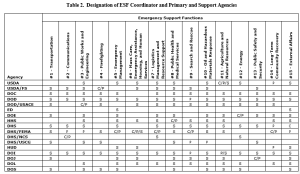
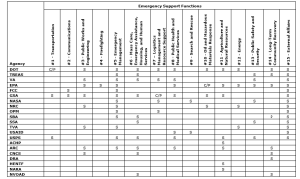
C = ESF coordinator P = Primary agency S = Support agency
Note: Components or offices within a department or agency are not listed on this chart unless they are the ESF coordinator or a primary agency. Refer to the ESF Annexes for details.
State Of Idaho Annex Assignments
The State of Idaho has included additional items on their list beyond the regular ESF’s. The purpose is so that during times of specific emergencies a designated agency is to respond. You will also notice that there is provision for coordination with Tribes. Idaho has 5 tribal reservations and under Federal Statues they area considered separate nations and Idaho has no jurisdiction within the boundaries of the reservations. Response within a tribe is entirely the responsibility of the tribal council. However, as we all know disasters do not recognize “bright lines” between governmental jurisdiction. You will notice that the Public Health Districts are listed in the State Plan and at the Ada County Level the local health district is listed. This would be the same in all 44 counties in Idaho. Each county Emergency Operations Plan will list the local health district for that county.
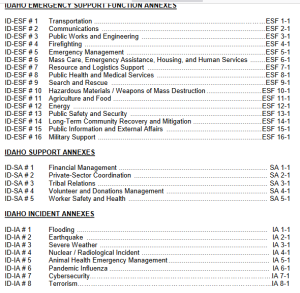
Idaho’s ESF Listing – Note the similarities as far as which agency is primary for a specific ESF and at Federal Level.
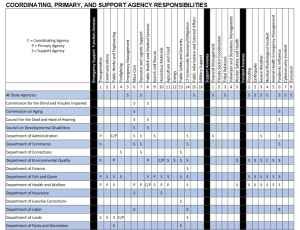

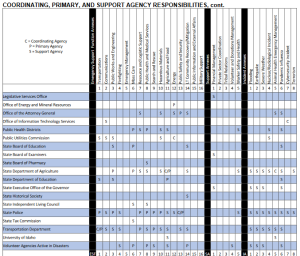
The following is the ESF assignment sheet for Ada County. You can see how the two are tied together. Also notice that Central District Health Department is the Primary for ESF#8. Looking at ESF#8 under the Federal Scheme the Federal Department of Health and Human Services is Primary. In the State of Idaho you will see the Idaho Department of Health and Welfare. You will notice that ESF#8 is divided in Ada County with Central District Health Primary on ESF#8A and the Ada County Paramedics Primary for ESF#8B.
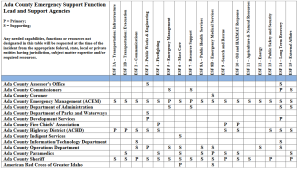
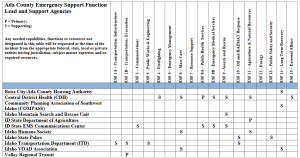
Situation Reports -known as Sitreps.
If you remember from your FEMA classes during an emergency a daily action plan is developed by the planning section during the Emergency. Part of the Daily Action plan is to summarize what has happened and to look down the road. These are updated daily. If you look at the National Interagency Fire Center’s site you will see Sitreps for that various fires.
04.06 Discussion Forum (1 hr) -Situation Reports-Link to Canvas Site
For this discussion, we will be looking at a Situation Report (Sit Rep) for the Covid situation in Multnomah County Oregon which includes the city of Portland. During an emergency the responsibility of the Incident Commander is to create a Situation Report so that everyone is aware of the status of the response. I have provided Sit Rep 65 from the county from many.
Pre-Discussion Work
To begin this assignment, review the following resource: Granted this is old but I believe it shows you the depth to which a SitRep can and needs to be developed during a public health crisis such as we observed during Covid.
Situation Report Multnomah County Oregon May 22, 2020.
Drafting Your Response
Next, prepare your forum post by creating a Google document. On your document, answer the following questions:
- What is your initial impression of the Sit Rep?
- What is in the Sit Rep that you might not expect to be reported out?
- After reading the report what question might you have for the Incident commander.
- In the next module we will be looking at emergency communication. What stands out to you about the public information section of the Sit Rep?
Be sure to support your responses by referencing materials from this module. Also, once you have answered the questions, be sure to proofread what you wrote before you share it.
Discussing Your Work
To discuss your findings, follow the steps below:
Step 01. After you have finished writing and proofreading your responses, click on the discussion board link below.
Step 02. In the Discussion Forum, create a new thread and title it using the following format: Yourname and the topic of the discussion board.
Step 03. In the Reply field of your post, copy and paste the text of your composition from the Document you created.
Step 04. Add bolding, underlining, or italics where necessary. Also, correct any spacing and other formatting issues. Make sure your post looks professional.
Step 05. If you need to upload a document or image you can do so by clicking on the Upload image (photo image button) or Upload document (Document button) in the text editor and locating and selecting your document from your computer.
Step 06. When you have completed proofreading, fixing your post formatting, and attaching your file, click on the Post Reply button.
Below is an example from the 2022 fire season on a fire that is outside of Salmon Idaho
Moose Fire
With continuing warmer weather, drying of light fuels, and shifting, gusty winds, fire activity within the fire perimeter might increase. Residents may see smoke develop as pockets of previously unburned fuels within the fire perimeter and near the fire’s edge are consumed. These smokes are continuously being monitored by air or ground resources, with crews still engaged on the southeast flank where safe to do so.
In the Diamond Creek, Stormy Creek, Bob Moore, Morning Glory, Savage Ranch and Wallace Creek structure protection areas, pumps were removed, and hose lay were left in place. The removal of the pumps was done to protect them from freezing and, if necessary, can quickly be reinstalled for structure protection. Firefighters and heavy equipment operators will be working closely with resource advisors (READS) to implement plans of action for suppression repair operations. Suppression repair objectives are to return damaged areas to a stable condition that reflects pre-fire conditions. We will continue working with local ranchers to identify their cattle and removing them from the fire area as quickly and safely as possible.
Basic Information
| Current as of | 9/19/2022, 5:46:32 PM |
| Incident Type | Wildfire |
| Cause | Human |
| Date of Origin | Sunday July 17th, 2022 approx. 04:00 PM |
| Location | 17 miles north of Salmon, ID |
| Incident Commander | Evans Kuo, Great Basin Incident Management Team 1 |
| Incident Description | wildfire |
| Coordinates | 45.375 latitude, -114.091 longitude |
Current Situation
| Total Personnel | 693 |
| Size | 130,093 Acres |
| Percent of Perimeter Contained | 51% |
| Estimated Containment Date | Monday October 31st, 2022 approx. 12:00 AM |
| Fuels Involved | Short Grass (1 foot)
Brush (2 feet) Timber (Litter and Understory) Fuel loading is moderate in grass and shrubs; and low in timber, grass and understory. In young to mid-age timber reproduction, fuel loading in grass and shrubs is light with a high loading of dead and down material. |
| Significant Events | Minimal Backing Creeping Smoldering
Heavies continue to consume. Limited creeping. |
Outlook
| Planned Actions | Division A/X/Owl:
Keep fire from impacting the Salmon River road. Remove debris from roadways to provide safe access into and out of area. Stage equipment in Divisions that can respond to mud flows or debris on roadways. Complete suppression repair across the Division. Eliminate potential threat to private property and values at risk within the Owl Creek drainage. Use air resources to monitor fire, if any threat is detected, use air resources to reduce fire intensity. Division M: Hold fire west of Diamond Creek Road from Diamond Creek south to the Stormy Peak Road at Salmon then west along Old Leesburg Road. Keep the fire north of Old Leesburg and the fuel break along the powerline. Use UAS to identify heat sources so crews can take appropriate suppression action to reduce fire intensity and impacts to the watershed. Division N: Minimize fire effects and limit spread into the Salmon Municipal watershed. Use UAS to identify heat sources enabling crews to take appropriate suppression actions in an efficiently and effective manner. Division O: Minimize fire effects and spread north of the Powerline and west of the Ridge Road. Use UAS to identify heat sources so crews can take appropriate suppression action. Work with fuels removal group to remove locks along powerline to designated deck areas. Division T/W: Patrol and monitor containment lines. Remove all excess suppression equipment. Complete chipping along containment lines. Start suppression repair as identified in the suppression repair plan. Protect critical values at risk to the Beartrack Mine and Leesburg infrastructure. Back haul excess equipment, maintain sprinkler protections systems where fire threats remain. Start suppression repair as identified within the suppression repair plan. Fuels Removal Group: Use heavy equipment to consolidate and relocate existing logs along FS 020 to specified locations as determined by Salmon-Challis Forest staff. Remove residual slash created by previous suppression efforts away from containment lines to specified locations. Road Maintenance Group: Continue to grade and smooth road surfaces to improve access for the public and fire suppression traffic. Maintain adequate water on the Deep Creek Road from Panther Creek to Williams Summit. |
| Projected Incident Activity | 12 Hours:
Minimal fire behavior overnight due to good relative humidity recovery and past day’s rains. Increased rollout and rock fall. Smoldering and creeping fire with snags and rollout. 24 hours: Warmer and drier conditions. Fire behavior will predominantly be creeping and smoldering with limited forward movement in areas where canopy cover deflected rainfall. Concern for reburn in areas of scorched needles and heat sources from stumps and large logs. Rollout and rock fall will continue. 48 hours: Cooler temperatures and a return of more moist conditions will again limit fire potential. The onset of the showers may include gusty conditions prior to the precipitation. Fire behavior will predominantly be creeping and smoldering with some surface burning in areas where sun, wind and slope occur. Concern for reburn in areas of scorched needles and heat sources from stumps and large logs. Rollout and rock fall will continue. 72 hours: Cooler with a high chance of precipitation will likely limit fire activity. There will be gusty winds occurring prior to the rain which could cause increasing fire behavior. There will be increasing chance of thunderstorms and showers with associated gusty winds and lightning. Anticipated after 72 hours: Temperatures may be trending back up with drier conditions for this period. If predicted rainfall does not occur, fire behavior may pick up. Concerns over road conditions and increased rollout of rocks and logs. |

